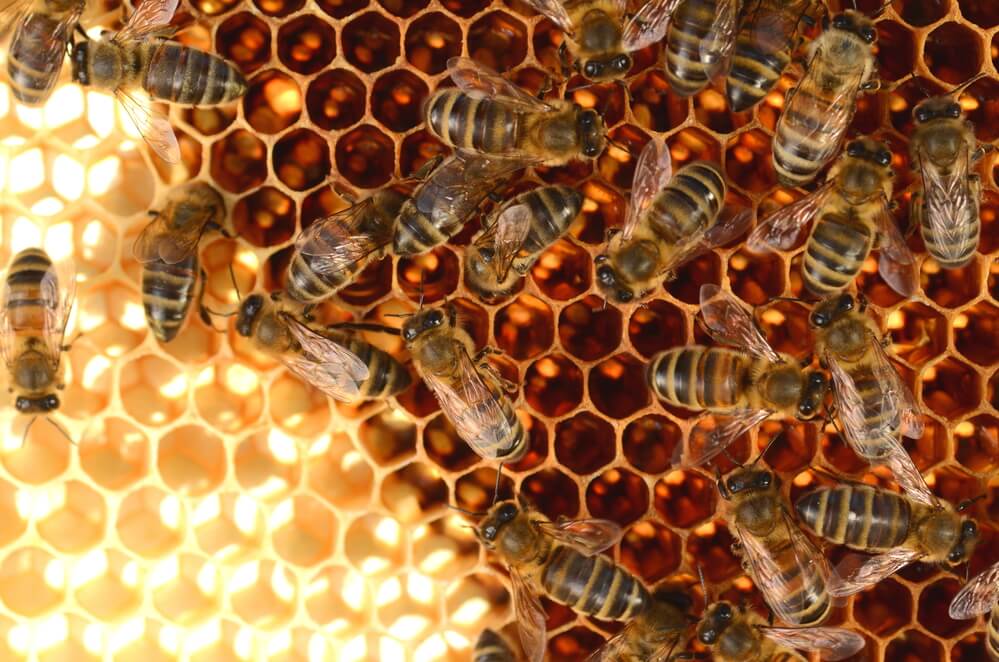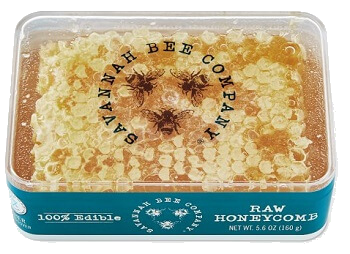Table of Contents:
How Do Bees Make Honey?
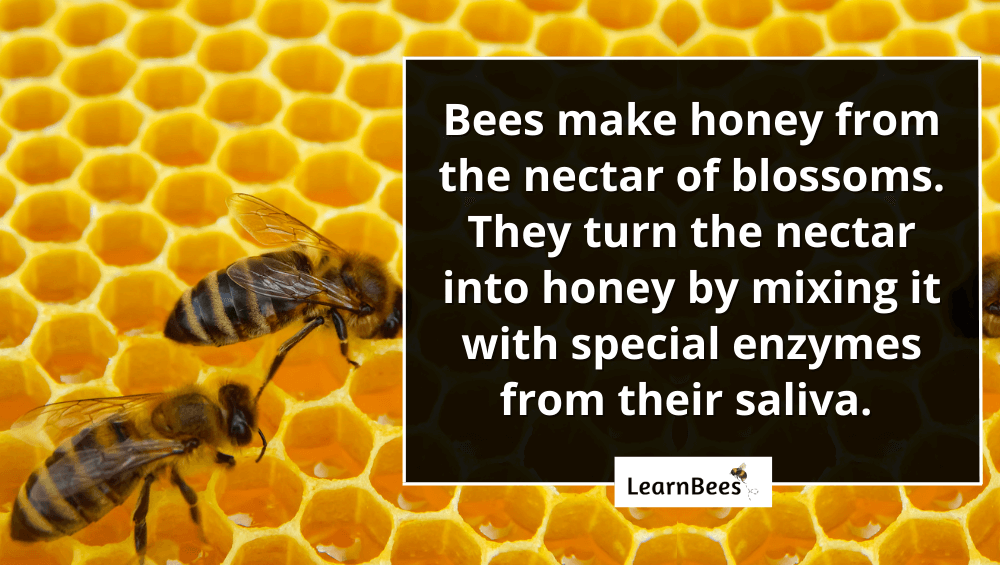
Simply put:
Bees make honey from the nectar of flowers.
They transform the nectar into honey by mixing it with enzymes from their saliva. From there, they remove the excess water from the honey and put it inside the honeycomb for storage.
But here’s the interesting part:
The flavor of the nectar determines the flavor of honey nectar.
For example, nectar collected from blueberry flowers will have a delicate blueberry taste. This is what gives us blueberry honey.
Likewise, nectar collected from orange blossom flowers will have a faint citrusy taste. This is what gives us orange blossom honey.
But now you might be wondering:
How do bees make honey step by step?
It starts with forager honeybees. Forager honeybees are responsible for leaving the hive to gather food for the colony. A bee’s main diet includes pollen and nectar from flowers.
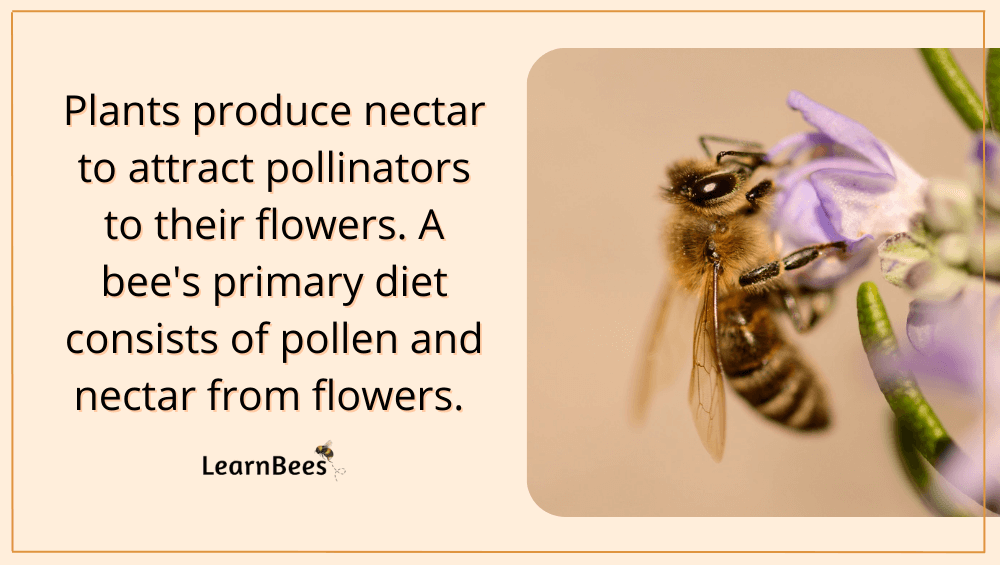
More specifically, nectar is a sugary liquid produced by plants that bees use to make honey. Thanks to their long tongues, bees slurp up the nectar and store it inside their ‘honey crop.’ The honey crop is an internal organ bees use to temporarily store things.
And here’s where it gets interesting:
Bees have an enzyme in their saliva called invertase, which is a unique and magical ingredient that turns nectar into honey.
So the bees fly back to their hive once they have a full load of nectar stored inside their honey crop. A hardworking little bee can visit anywhere from 50-100 flowers on a single trip.
Once back at the hive, the forager bees regurgitate the nectar out of their honey crop and into the mouths of the bees at the hive.
The bees that collect the nectar at the hive are called ‘house bees.’ House bees are responsible for cleaning the hive, tending to the baby bees, and making honey.
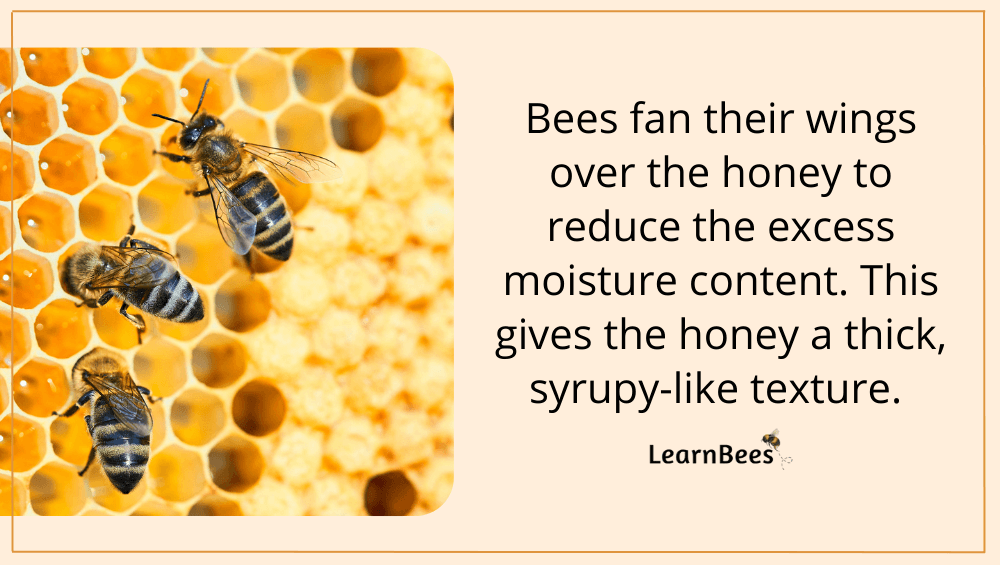
And what happens next?
The house bees add more special enzymes to the nectar until it fully turns into honey. Then the bees regurgitate it into the honeycomb cells, which are like tiny honey containers made of beeswax.
The honey is still watery, so the bees fan it with their wings to dry it. Once the moisture content lowers, the honey begins to thicken into a sweet, syrupy goodness. Finally, the bees seal the honeycomb cells with a wax lid to keep the honey clean.
That’s it.
That’s how bees make honey.
In summary, here’s a step-by-step list of how honeybees produce honey:
- Step One: Forager bees collect nectar from flowers and store it inside their honey crop
- Step Two: They fly back to their hive and give the house bees the stored nectar
- Step Three: The house bees then turn the nectar into honey by mixing it with a special enzyme in their saliva called “invertase”
- Step Four: The bees place the honey inside the honeycomb, then fan their wings over it to reduce the excess water
- Step Five: Once the honey thickens, the bees seal off the honeycomb with wax
Why Do Bees Make Honey?

Bees make honey for one reason:
To eat it.
More importantly, honeybees make honey to eat during the winter when they cannot collect food from flowers. You see, a bee’s main diet consists of pollen and nectar from flowers. When flowers are scarce during the harsh winter months, then the bees need something to fall back on.
This is where honey comes in.
Bees essentially make honey so they can save it for a rainy day. Honeybees won’t survive the winter if they don’t have enough honey stored.
Now you might be asking:
What do bees do when beekeepers take their honey?
Great question. Honeybees are known for producing a surplus of honey. In fact, a single hive can make up to 100 pounds of honey per year.
But beekeepers don’t take all their honey. Instead, they only harvest a portion of the honey while leaving the rest for bees.
If the honeybees don’t have enough honey available, such as if they’re a newer colony that isn’t established, then the beekeeper won’t harvest any of their honey.
Do All Bees Produce Honey?
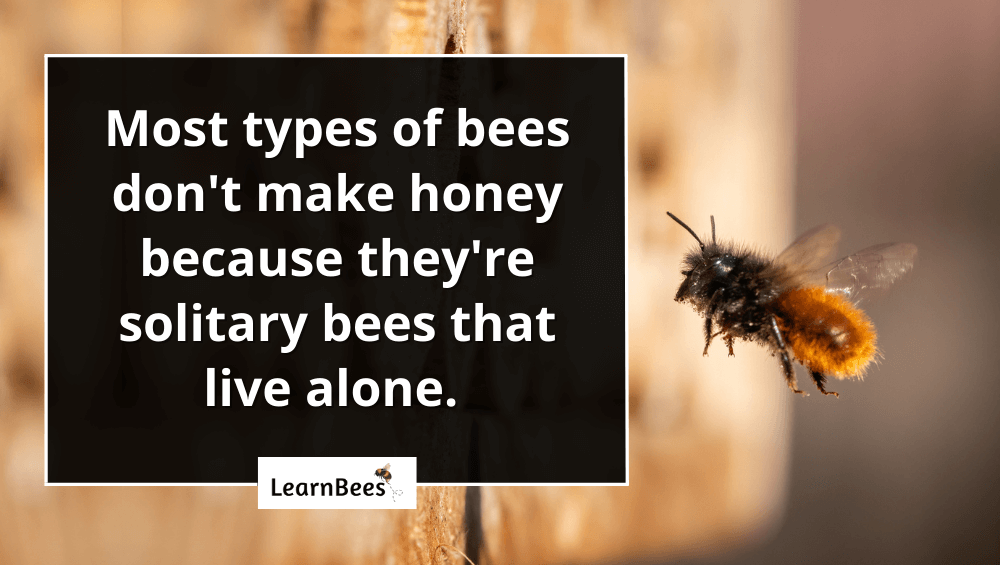
No, in fact, quite the opposite.
Most types of bees don’t make honey.
Keep in mind, there are more than 20,000 bee species. However, the majority of bees are solitary creatures that live alone. Common examples include mason bees, carpenter bees, and sweat bees.
And here’s the thing:
You’ll notice that social bees, like honeybees, are the main type of bee that produces honey.
Social bees live in large colonies with hundreds or even thousands of other bees. Making honey is a big job that requires the helping hands of other bees.
So solitary bees, like mason bees, simply don’t have the time or resources available to produce honey. Mason bees also have short lifespans of about four weeks. They spend most of their time nesting and collecting pollen and nectar from flowers.
So, in short?
Honeybees are the primary type of bee that produces honey – hence where they get their name.
Other types of bees, like bumblebees, produce small amounts of honey. However, bumblebees don’t produce nearly the same amount of honey that honeybees do.
This explains why the raw honey you buy from the grocery store comes exclusively from honeybees. They’re the only bee species that make enough honey for human consumption.
FAQs on “How Do Bees Make Honey?”
- How do bees make honey step by step?
- What do bees make honey for?
- How many bees does it take to make honey?
- Is honey made from bee vomit?
- Is honey made by bees’ poop?
- What do bees make honey out of?
- Can we make honey without bees?
- Is honey bee sperm?
- How do bees make honey in the winter?
- Do bees only make honey in the spring and summer?
- How long does it take for bees to make honey?
- How do bees make honey without a queen bee?
- How do bees make honey without worker bees?
- Can small beehives make honey?
- How do bees make honey from pollen?
How do bees make honey step by step? How is honey made?
Here’s the step-by-step process of how honeybees produce honey:
- Step one: Bees collect nectar from flowers and store it inside an internal organ called a ‘honey crop.’
- Step two: Bees mix enzymes from their saliva into the nectar, which helps turn it into honey
- Step three: The bees place the honey in honeycomb cells, then fan their wings to evaporate the extra water content
- Step four: They seal off the honeycomb with wax to keep out moisture and debris
—> Go back to the FAQs on “How Do Bees Make Honey?”
More to Explore:
- Do Queen Bees Eat Honey?
- Are Worker Bees Male or Female?
- Queen Bee Versus Worker Bees – How Do They Compare?
What do bees make honey for?
Bees make honey for two reasons: to feed themselves and their young.
Bees rely on honey during the winter when there aren’t as many flowers blooming. Honey is an excellent source of energy and nutrients. Without it, honeybees wouldn’t survive the harsh winter months.
This is why beekeepers only harvest a portion of the honey from their hives. They leave enough for the bees to eat during the winter.
—> Go back to the FAQs on “How Do Bees Make Honey?”
More to Explore:
- Do Carpenter Bees Pollinate?
- How Long Do Bumble Bees Live?
- Honeybees vs. Bumblebees: How Do They Compare?
How many bees does it take to make honey?
There is no magic number.
However, the bigger and more established the colony is, the more honey it will make. For example, a large colony full of 50,000 honeybees has more resources needed to produce more honey. They have more bees foraging for nectar and more bees inside the hive making honey.
—> Go back to the FAQs on “How Do Bees Make Honey?”
More to Explore:
Is honey made from bee vomit?
No, this is just a myth. Some people believe that honey is bee vomit because it gets regurgitated from their mouths. But regurgitation is not the same as vomit.
To learn more, read Is Honey Bee Vomit?
—> Go back to the FAQs on “How Do Bees Make Honey?”
More to Explore:
- Ground Bees: Are They a Threat to Your Yard?
- Wasps vs. Honeybees: Are They Different?
- Do Bumble Bees Bite?
Is honey made by bees’ poop?
No, this is another myth. Honey doesn’t come out of a honeybee’s rectum. It is not poop.
To learn more, read Is Honey Bee Poop?
—> Go back to the FAQs on “How Do Bees Make Honey?”
More to Explore:
What do bees make honey out of?
Bees make honey out of nectar, which is a sugary substance that flowers produce. Nectar is a source of carbohydrates for bees. It gives them the energy to fly, walk, and perform daily tasks.
WIthout nectar and pollen from plants, bees would starve. Remember, bees are vegetarians that rely on plants for food. They don’t eat other insects.
—> Go back to the FAQs on “How Do Bees Make Honey?”
More to Explore:
Can we make honey without bees?
By definition, honey is a sweet, syrup-like fluid made by bees and other insects from the nectar of blossoms. So according to that definition, genuine honey can only be made by insects.
However, some companies are beginning to toy with the idea of making synthetic honey that offers the same taste and health benefits as real honey.
In 2021, a company called MeliBio launched the world’s first man-made honey.
The company uses precision fermentation, synthetic biology, and plant science to make molecularly identical honey. This means it offers the health benefits and delicious taste of honey without the downsides linked to commercial honey production.
—> Go back to the FAQs on “How Do Bees Make Honey?”
More to Explore:
Is honey bee sperm?
No, this is another myth about honey. It is not bee sperm.
In fact, honey isn’t even made by male bees in the first place. Female worker bees produce honey.
—> Go back to the FAQs on “How Do Bees Make Honey?”
More to Explore:
How do bees make honey in the winter?
Generally, honeybees don’t produce honey in the winter. They become less active when it’s cold because they need to conserve energy to keep themselves warm. So they huddle together inside their hive to form a warm cluster.
But it really depends on the climate in which the bees live.
For instance, in warmer climates such as Australia or South America, honeybees can remain active all year round. This is because bees thrive in warm weather, where flowers can grow throughout the year.
However, in colder climates like North America or Europe, bees typically only produce honey during the spring and summer months.
—> Go back to the FAQs on “How Do Bees Make Honey?”
More to Explore:
Do bees only make honey in the spring and summer?
“What months do bees make honey?” is a common question we get.
Honeybees make most of their honey in the spring and summer. These are the peak seasons for honeybees.
The bees will start slowing down once the weather gets colder. In colder climates, bees will stay inside their hive to stay warm during the winter. This is when they’ll use their honey storage for food.
In warmer climates, honeybees may remain active all year round.
—> Go back to the FAQs on “How Do Bees Make Honey?”
More to Explore:
How long does it take for bees to make honey?
It depends on the colony size and health.
It typically takes 3-4 weeks for a new hive to start the honey-making process. Beekeepers will not harvest honey from a new hive during their first year because they need time to become established. New hives don’t produce a surplus of honey like established hives do.
On the other hand, strong and established hives can fill several honey supers within just a few short weeks. This, of course, happens under the right conditions, such as weather and nectar flow.
—> Go back to the FAQs on “How Do Bees Make Honey?”
More to Explore:
How do bees make honey without a queen bee?
They can’t.
Bees cannot survive without their queen. She’s the only bee in the colony that can lay fertilized eggs. So if the queen bee dies unexpectedly, the honeybee colony rushes to replace her quickly.
If they can’t, then the colony will be doomed to fail – with or without honey.
—> Go back to the FAQs on “How Do Bees Make Honey?”
More to Explore:
How do bees make honey without worker bees?
They don’t. Worker honeybees are needed to collect nectar and turn it into honey. Neither the queen bees nor drone bees make honey.
—> Go back to the FAQs on “How Do Bees Make Honey?”
More to Explore:
Can small beehives make honey?
Yes, small beehives can make honey. They have to start somewhere.
—> Go back to the FAQs on “How Do Bees Make Honey?”
More to Explore:
How do bees make honey from pollen?
Honey is made from nectar, not pollen.
That said, honey may contain small traces of pollen when the bees are making it. This is because bees eat pollen and might have some pollen particles in their mouths when they’re regurgitating the honey into the honeycomb cells.
